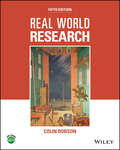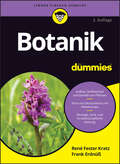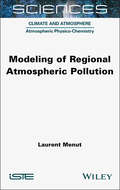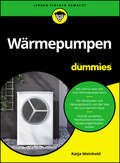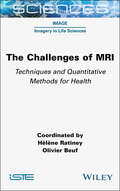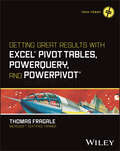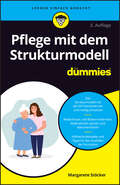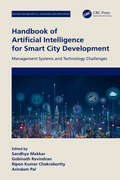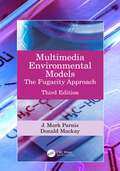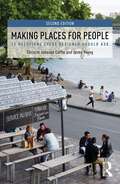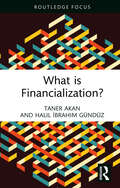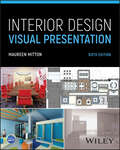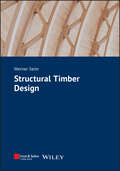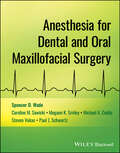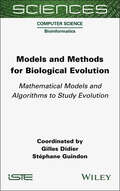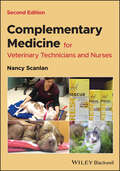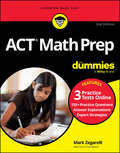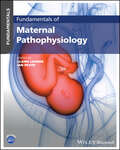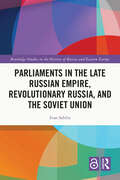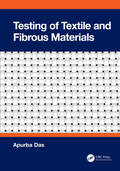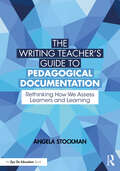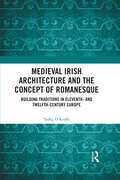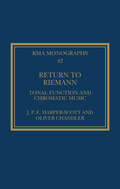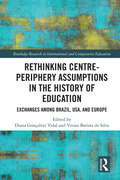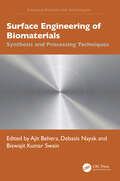- Table View
- List View
Real World Research
by Colin RobsonREAL WORLD RESEARCH Provides students and practitioner alike with clear and systematic guidance on performing social research in applied settings Real World Research supplies the multidisciplinary skills necessary to conduct social research projects inside and outside of the classroom or the workplace. Offering well-balanced coverage of qualitative, quantitative, and mixed methods, this highly practical resource incorporates approaches from different social science disciplines to help readers find answers to real-life research questions in healthcare, education, business and management, and in many other public and private settings. Detailed yet accessible chapters include step-by-step advice for developing a research question, choosing a research design strategy, collecting and analyzing the data, interpreting and reporting the results, and more. The fifth edition contains timely coverage of contemporary methodologies, key ethical issues, and ongoing debates within the field of social research. New and expanded sections address topics such as evidence‐based approaches to social research, ethical considerations when conducting research involving people, carrying out projects based solely on existing research, and the importance and implications of internet-based research. Featuring a wealth of up-to-date examples drawn from a wide range of disciplines, this classic textbook: Focuses on useful real-world research in applied settings such as homes, schools, businesses, and other workplaces Provides a concise overview and a well-defined example of each main step of the research process Highlights the importance of collaboration, cooperation, and active participation in social research Explains flexible research designs using largely qualitative methods, including additional coverage of ethnographic and grounded theory approaches Includes an extensive companion website with numerous research examples, links to journal articles, PowerPoint slides, and many other additional resources Real World Research, Fifth Edition, remains essential reading for those tasked with developing, performing, and reporting the findings of a research project, including students, academics and educators, social scientists, health practitioners, and professionals in a diverse range of fields.
Botanik für Dummies (Für Dummies)
by Rene Fester Kratz Frank ErdnüßVon der Wurzel bis zum Blatt – alles, was die Botanik zu bieten hat Mit diesem Buch verschaffen Sie sich ganz einfach einen umfassenden Überblick über die Botanik. Von den zellbiologischen Grundlagen über die verschiedenen Pflanzengewebe und -strukturen bis hin zu Physiologie, Genetik, Systematik und Ökologie: Jederzeit leicht verständlich vermittelt es Ihnen das nötige Basiswissen, das Sie in Ausbildung, Studium oder als botanisch interessierte Person benötigen. Themen wie Biodiversität, Biotechnologie, Einfluss von Klima, Agrar- und Forstwirtschaft oder die Bedeutung von Pflanzen für den Menschen runden das Buch ab. Sie erfahren Was die grundlegenden Prinzipien pflanzlichen Lebens sind Wie Pflanzen auf Umweltbedingungen reagieren und sich vermehren Wie Pflanzen systematisch eingeteilt werden Welche Schlüsselrolle Pflanzen im Ökosystem zukommt
Modeling of Regional Atmospheric Pollution
by Laurent MenutThis book describes the main concepts used to develop and implement chemistry-transport models to calculate the evolution of regional air pollution. Since physico-chemical principles are already widely presented in various works, the perspective chosen for this book concerns the modeling of these processes. As modeling can be a simplification of reality in a particular study framework, we will try to show whether the processes represented are well modeled or not. For each process, we will discuss the simplifying assumptions that have been made, the various possible ways for improvement and the impact of these simplifications on the desired results. General information on pollution is presented, followed by observations, legislation, modeling of meteorology and then chemistry-transport, anthropogenic and natural emissions, depots, validation of calculations, optimization and data assimilation.
Wärmepumpen für Dummies (Für Dummies)
by Katja WeinholdSie möchten verstehen, wie Wärmepumpen funktionieren, wie Sie sie in Ihr (bestehendes) Heiz- und Kühlsystem optimal integrieren, welche Förderung Sie erhalten und welche Kosten im Falle eines Einbaus auf Sie zukämen? Dann ist dieses Buch wie für Sie gemacht. Es erklärt die Technik leicht verständlich, macht mögliche Kosten transparent und unterstützt Sie so bei der Entscheidungsfindung. Darüber hinaus zeigt es Ihnen ganz konkret, welche Schritte Sie unternehmen müssen, wenn Sie sich für einen Einbau entscheiden.
The Challenges of MRI: Techniques and Quantitative Methods for Health
by Olivier Beuf Helene RatineyAfter a review of the essential concepts of magnetic resonance imaging (MRI), The Challenges of MRI presents the recent techniques and methods of MRI and resulting medical applications. These techniques provide access to information that goes well beyond anatomy, with functional, hemodynamic, structural, biomechanical and biochemical information. MRI allows us to probe living organisms in a multitude of ways, guaranteeing the potential for continuous development involving several disciplines: physics, electronics, life sciences, signal processing and medicine. This collective work is made up of chapters written and designed by experts from the French community. They have endeavored to describe the techniques by recalling the underlying physics and detailing the modeling, methods and strategies for acquiring or extracting information. This book is aimed at master’s students and PhD students, as well as lecturers and researchers in medical imaging and radiology.
Getting Great Results with Excel Pivot Tables, PowerQuery and PowerPivot (Tech Today)
by Thomas FragaleGet more out of your data with step-by-step tutorials for the Excel features you need to know Excel is still the most popular tool for organizing and analyzing data, and today's professionals are expected to have a high degree of fluency with it. Complex Excel tools like Pivot Tables, PowerQuery, and PowerPivot can help you manage and report on data the way you need to. Getting Great Results with Excel Pivot Tables, PowerQuery and PowerPivot offers a fresh look at how these tools can help you. Author and Microsoft Certified Trainer Thomas Fragale breaks down the topics into easy-to-use steps and screenshots, so you'll be able to put your advanced Excel skills into practice right away. Using Pivot Tables, PowerQuery, and PowerPivot, you can import, sort, transform, summarize, and present your data, all without having to be a programmer. This book takes the technical jargon out of using these features, so you can do your job more efficiently, bring value to your teams, and advance your career. The plain-English instructions inside will help anyone learn to get quick, meaningful results from your data, without having a degree in computing. Get easy-to-understand walkthroughs for analyzing data and creating dashboards in Microsoft Excel Learn how to organize data in Excel and use advanced features to find patterns and insights Summarize any kind of data faster and easier, leaving you more time for other tasks Turn raw numbers into new knowledge, reports, and charts that tell coworkers and customers what they need to know This book is great for anybody who has tons of raw data and needs to make sense of it. Managers, salespeople, finance professionals, marketers—along with anyone else who works with large amounts of data—will love this quick and easy guide to Pivot Tables, PowerQuery, and PowerPivot.
Pflege mit dem Strukturmodell für Dummies (Für Dummies)
by Margarete StöckerSo funktioniert gute Pflege — ambulant und stationär Das Buch stellt das Strukturmodell für die Pflegeplanung und dessen Kernelement, die SIS® (Strukturierte Informationssammlung), in ihrer aktualisierten Form vor. Die Autorin erklärt die mit dem Modell verbundenen Formulare und zeigt den Pflegenden Schritt für Schritt und anhand von Beispielen und typischen Pflegefällen, wie sie die Formulare ausfüllen und damit die Dokumentationspflicht erfüllen können und die pflegebedürftige Person in den Mittelpunkt stellen. Das Buch richtet sich an Auszubildende im Pflegebereich, Pflegefachkräfte in stationären und ambulanten Einrichtungen, soziale Dienste und Betreuungskräfte. Sie erfahren Wie die SIS® aufgebaut ist und wie die Formulare korrekt ausgefüllt werden Wie einfach die Prozessplanung mit dem Modell umzusetzen ist Warum die Perspektive des Pflegebedürftigen so wichtig ist
Handbook of Artificial Intelligence for Smart City Development: Management Systems and Technology Challenges (Big Data for Industry 4.0)
by Sandhya Makkar Gobinath Ravindran Ripon Kumar Chakrabortty Arindam PalThis handbook explores smart cities of the future, provides an understanding of their development and management systems, and discusses the technology challenges. It also discusses why and how humankind can benefit from them.Handbook of Artificial Intelligence for Smart City Development: Management Systems and Technology Challenges covers the whole journey of the development of smart cities, from the foundations to the usage of technologies, including the challenges and issues that policymakers and technologists may face during the concept, development, management, and implementation stage. The book also covers sustainable strategies and safety measures and offers real-life cases and advancements in manufacturing approaches for smart cities. The book includes upcoming AI technologies such as big data analytics, blockchain, machine learning, fault diagnostics, and a lot more.This handbook is intended to appeal to readers from industry and research. The book is also meant for academicians and students from across many disciplines. Moreover, this book is a medium for consultants, government agencies, and policymakers to grapple with topics and perspectives outside their lane
Multimedia Environmental Models: The Fugacity Approach
by J. Mark Parnis Donald MackayMultimedia Environmental Models: The Fugacity Approach, Third Edition, takes a broad approach of viewing chemical behavior in the total biosphere of connected biotic and abiotic compartments. Chemicals are subject to the laws of "mass balance," a constraint that provides the opportunity to establish quantitative expressions for chemical fate that are central to chemical management and regulatory legislation. This book employs both the conventional concentration-based procedures and those based on application of the more elegant and powerful concept of fugacity to characterize equilibrium, steady-state distribution, and time-dependent transport between environmental phases such as air, water, and soil. Organic chemicals are emphasized because they are more easily generalized when assessing environmental behavior.Features Illustrates professional approaches to calculating the fate of chemicals in the environment Explicitly details all worked examples in an annotated step-by-step fashion Presents real-life freely downloadable models of use to government, industry, and private consulting professionals and students alike Clarifies symbols and notation
Making Places for People: 12 Questions Every Designer Should Ask
by Christie Johnson Coffin Jenny YoungMaking Places for People explores 12 social questions crucial to environmental design. Authors Christie Johnson Coffin and Jenny Young bring perspectives from practice and teaching to challenge assumptions about how places meet human needs. In this expanded second edition, the authors continue to explore the complexities of basic questions, such as: What is the story of this place? What logic orders it? How big is it? How sustainable is it? They consider the impact on making places of pandemic, climate change, human migration, and contemporary discussions of diversity, equity, and justice. Short, approachable, easy-to-read chapters, illustrated with updated examples of projects from around the world, bring together theory, methodology and key research findings. Understanding experienced and research-based connections between people and built form can inspire designs that make places of meaning and delight. This second edition will be essential reading for design students and professionals.
What is Financialization? (Routledge Frontiers of Political Economy)
by Taner Akan Halil İbrahim GündüzThis book introduces a new and original analytic approach to defining, understanding, and explaining financialization. It provides a precise and quantifiable definition of financialization, disaggregating financialization into its three varieties. These are examined through the lens of financial development, both before and after the Great Recession, providing the most in-depth analysis of the finance-real economy-labor nexus. It provides a historical perspective, looking at financialization as a key dynamic that has shaped real economic structures in terms of both growth and inequality of income over the last four decades in high-income, upper-middle-income, and lower-middle-income countries. The book makes its multidisciplinary content readily accessible to non-economists by providing economics background information, and to economists by providing social-theoretical context. It will be essential reading for academics, researchers, analysts, and students of economics, business, finance, sociology, politics, and international relations. It will also serve as a vital resource for policy-makers and bureaucrats in determining, formulating, implementing, and revising policy alternatives to govern the pros and cons of financial development in terms of its effects on real output and income inequality.
Interior Design Visual Presentation
by Maureen MittonINTERIOR DESIGN VISUAL PRESENTATION Comprehensive guide covering all aspects of visual design, including planning, layout, and presentation. Interior Design Visual Presentation comprehensively addresses the visual design and presentation skills of the interior designer, featuring thorough, process-oriented coverage on the planning, layout, and the design of interior building spaces and guiding readers through techniques for executing creative and successful design graphics, models, and presentations. Color illustrations throughout the text feature a wide array of residential, institutional, and commercial settings designed to highlight step-by-step instructions. This newly updated and revised Sixth Edition includes a new overview of the design process for commercial design for students at all levels. Other revisions include new discussion of the impact of digital communication, examples of rendering materials in color, review of the latest tools for digital rendering, additional detail on creating hand drawings, and advanced technologies for physical model making, along with updated 3D modeling tutorials on Sketchup, Revit, Photoshop, and discussion of building information management (BIM) related to design intent and hand and digital rendering. Interior Design Visual Presentation includes information on: The design process and related graphics, covering diagrams and programming analysis graphics, programming matrices, schematic design, and design developmentParaline and perspective drawings, and sketching interior environments using photographs and perspective grid chartsMaterials, media, and tools involved in rendering by hand and constructing physical and digital scale modelsOrganization and composition guidelines when constructing boards, physical presentations, and digital presentationsGraphic design components, public speaking, and design communication when making a complete presentation Covering all aspects of visual design and presentation that interior designers need to know, Interior Design Visual Presentation is a highly accessible and valuable resource for students and professors in primarily first- and second-year courses in interior design degree programs, along with professional interior designers studying for the NCIDQ exam.
Structural Timber Design
by Werner SeimStructural Timber Design Timber construction has been one of the most innovative areas of the building industry for several years. The speed with which new products are introduced into practical application is almost breathtaking compared to the other construction materials in the building industry. As a result, timber construction is continuously increasing its market share in commercial buildings and hall structures, and even in multi-storey construction for residential and office buildings. This book provides essential knowledge and skills required for the design, detailing, and construction of timber structures. Special emphasis is placed on the specific features of timber and wood-based materials compared to other construction materials. This concerns the numerous advantages, as e.g. the comparatively low weight, the good workability of the high-performance material and the large variety of assembling technologies, but also the challenges resulting from the material anisotropy and from the susceptibility to natural pests. In each chapter the essential phenomena are explained first and then brought into connection with code regulations. This aims to support the basic understanding of the interrelations and dependencies in timber engineering, which is the fundamental basis of creative engineering.
Anesthesia for Dental and Oral Maxillofacial Surgery
by Spencer D. Wade Caroline M. Sawicki Megann K. Smiley Michael A. Cuddy Steven Vukas Paul J. SchwartzAnesthesia for Dental and Oral Maxillofacial Surgery A comprehensive reference to anesthesia for dental, oral, and maxillofacial surgery Anesthesia for Dental and Oral Maxillofacial Surgery offers a comprehensive yet practical approach to anesthesiology for dentist anesthesiologists, oral and maxillofacial surgeons, and anesthesia providers in a dental environment. Taking a concise bulleted approach for fast access to information, the book covers all topics relevant to providing perioperative anesthetic management for the head and neck region. Coverage ranges from equipment, anatomy, physiology, and pharmacology to anesthetizing patients with specific conditions and for specific procedures. Designed for ease of use, the book makes it easy to find information relevant to cases ranging from common to rare. Anesthesia for Dental and Oral Maxillofacial Surgery readers will also find: Images throughout to facilitate key points A bulleted approach for easy reference A practical, accessible style, making it easy to find information at point of care Detailed coverage of preoperative aspects, pharmacology, key equipment, and more Anesthesia for Dental and Oral Maxillofacial Surgery provides anesthesia providers with all the information they need to confidently manage any case.
Models and Methods for Biological Evolution: Mathematical Models and Algorithms to Study Evolution
by Gilles Didier Stephane GuindonBiological evolution is the phenomenon concerning how species are born, are transformed or disappear over time. Its study relies on sophisticated methods that involve both mathematical modeling of the biological processes at play and the design of efficient algorithms to fit these models to genetic and morphological data. Models and Methods for Biological Evolution outlines the main methods to study evolution and provides a broad overview illustrating the variety of formal approaches used, notably including combinatorial optimization, stochastic models and statistical inference techniques. Some of the most relevant applications of these methods are detailed, concerning, for example, the study of migratory events of ancient human populations or the progression of epidemics. This book should thus be of interest to applied mathematicians interested in central problems in biology, and to biologists eager to get a deeper understanding of widely used techniques of evolutionary data analysis.
Complementary Medicine for Veterinary Technicians and Nurses
by Nancy ScanlanComplementary Medicine for Veterinary Technicians and Nurses p>Timely update of a practical reference book in complementary medicine with expansion of bibliographies, nutrition and diet, treatments, and therapies Complementary Medicine for Veterinary Technicians and Nurses provides a broad overview of complementary veterinary medicine in general, designed as a reference book covering the most commonly used complementary modalities, with an explanation of each modality and its historical background, procedure guidelines, and usefulness, along with practical tips. A range of both common and lesser-known modalities are covered, including physical therapy, holistic nutrition, acupuncture, chiropractic, Chinese, Western, and Ayurvedic herbal medicine, homeopathy, aromatherapy, and grief counseling. The text enables readers to assist with procedures associated with holistic medicine and knowledgeably discuss treatment options with clients. Outlining the respective roles of technicians and veterinarians throughout, Complementary Medicine for Veterinary Technicians and Nurses provides thorough coverage of integrative veterinary medicine in a user-friendly, digestible format. The book provides clinically-relevant patient history and release forms, a glossary of terms, quick reference charts, and contact information for additional resources and training. Written by a highly qualified author with significant experience in the field, Complementary Medicine for Veterinary Technicians and Nurses covers sample topics such as: TCM theory, chiropractic medicine, veterinary orthopedic manipulation (VOM), osteopathy, homeopathy, aromatherapy, and veterinary NAET Homotoxicology, applied kinesiology (AK), bach flower therapy, glandulars, cold laser therapy, magnetic therapy, ozone therapy, and prolotherapy BioNutritional analysis (BNA), immuno-augmentative therapy (IAT), color therapy, rife, EAV/Biotron, and animal communicators Detoxification, nutraceuticals, general nutrition, trigger point therapy, reiki, shiatsu, tuina, underwater treadmill therapy, and herbal pharmacy procedures Role of conventional medicine in a holistic practice, ozone therapy, pulsing magnetic field therapy, and assisi loop A unique resource covering different modalities that can be used to effectively treat health problems in animal patients, Complementary Medicine for Veterinary Technicians and Nurses is an essential resource for veterinary technicians and nurses, along with veterinarians and dedicated pet owners who wish to move beyond basic consumer resources.
ACT Math Prep For Dummies: Book + 3 Practice Tests Online
by Mark ZegarelliImprove your score on the math section of the ACT A good math score on the ACT exam can set you on the path to a number of rewarding college programs and future careers, especially in the STEM fields. ACT Math Prep For Dummies walks you through this challenging exam section, with simple explanations of math concepts and proven test-taking strategies. Now including access to an all-new online test bank—so you can hammer out even more practice sessions—this book will help you hone your skills in pre-algebra, algebra, geometry, trigonometry and beyond. Handy problem-solving tips mean you’ll be prepared for the ever-more-advanced questions that the ACT throws at students each year. Learn exactly what you’ll need to know to score well on the ACT math section Get tips for solving problems quicker and making good guesses when you need to Drill down into more complex concepts like matrices and functions Practice, practice, practice, with three online testsIf you’re a high school student preparing to take the ACT and you need extra math practice, ACT Math Prep For Dummies has your back.
Fundamentals of Maternal Pathophysiology (Fundamentals)
by Claire Leader Ian PeateFundamentals of Maternal Pathophysiology An introduction to pathophysiology specifically tailored to the needs of midwives Professional standards of proficiency require that midwives develop a robust understanding of pathophysiology, the study of disordered physical processes including disease and injury. This dedicated text equips both aspiring and registered midwives with the foundational understanding of pathophysiology required to deliver the best patient care. An understanding of pathophysiology is paramount for the delivery of safe and effective care during the various stages of pregnancy, childbirth and postpartum recovery. This understanding provides midwives with the insight to recognise and respond promptly to complications, fostering optimal outcomes for the mother and the newborn. Early recognition is pivotal, allowing for timely interventions that can significantly influence maternal and fetal well-being. A holistic approach to care is the cornerstone of midwifery and an understanding of pathophysiology allows midwives to consider the physical, emotional and social aspects of a woman’s health. This holistic perspective contributes to a more comprehensive and person-centred model of care. This user-friendly introduction is not only a foundational text but also a practical resource for practicing midwives. Informed by the latest research and reflective of current best practices, this book stands as an indispensable tool for this indispensable profession. Tailored for both undergraduate and graduate midwifery students, as well as registered midwives returning to practice, this resource is an invaluable asset in advancing pathophysiological knowledge within midwifery practice.
Parliaments in the Late Russian Empire, Revolutionary Russia, and the Soviet Union (Routledge Studies in the History of Russia and Eastern Europe)
by Ivan SablinThis book examines the meanings that were attached to the terms “parliament” and “parliamentarism” in the different historical and discursive contexts of the late Russian Empire, revolutionary and Soviet Russia, and the Soviet Union. It discusses those institutions referred to as parliaments by contemporaries, gives special attention to their functions, and traces the broader debates on parliamentarism within Russia and the Soviet Union, in Russian émigré circles, and among foreign observers. It highlights that only the late imperial and perestroika assemblies can be considered legislative institutions that expressed dissensus but argues that other assemblies, often referred to as “rubber-stamp” parliaments due to their lack of legislative competence and influence over other authorities, should not be dismissed. The Supreme Soviet, for instance, provided an integrative function binding society and elites in a top-down manner, while its deputies engaged in information acquisition and state micromanagement through interactions with their constituents. It also played an important role in interparliamentary relations and, as one of the first institutions of nominal parliamentarism in an autocratic single-party regime, of which there were many in the twentieth century, served as a model for numerous state socialist regimes. By addressing the role of parliaments in reassembling imperial spaces through political representation and the functions of nominal legislative institutions, the book explores the contribution of Russian and Soviet assemblies to global political modernity.
Testing of Textile and Fibrous Materials
by Apurba DasThis book contains detailed knowledge about testing principles of fibre, yarn, and fabric characteristics, the tensile characteristics of materials and testing of fibrous-composites and technical textiles. It starts with an introduction to textile testing and further covers moisture in relation to textile materials, sampling techniques for textile materials and the basic applied statistics, fibre characteristics, fibre length, cotton fibre fineness and maturity characteristics. It also deals with the advanced characterisation of cotton fibre by using HVI and AFIS systems.Features: It covers the principles of the testing of textile and fibrous materials along with modern techniques for testing textile materials It reviews all necessary topics related to fibre, yarn, fabric, technical textiles, and composite testing It explores the tensile characteristics of textile materials and measurement principles It discusses low-stress mechanical characteristics and transmission characteristics It includes a large number of examples and exercises based on actual industrial conditions worldwide including solutions This textbook is aimed at senior undergraduate students in textile testing and evaluation of textile materials.
The Writing Teacher’s Guide to Pedagogical Documentation: Rethinking How We Assess Learners and Learning
by Angela StockmanThis book is a call to action for English and English Language Arts teachers who understand that data are not numbers alone, learning is impossible to quantify, and students are our very best teachers.Writing teacher Angela Stockman shows us how pedagogical documentation—the practice of making learning visible, capturing what is seen and heard, and then interpreting those findings in the company of our students and our colleagues—is a humbling and humane practice that grounds what we think we’ve come to know in the lived experiences of those we intend to serve. In this rich resource, she offers: processes and protocols for documenting learning and analyzing data; resources and planning tools to help you design and execute your own projects; and a digital documentation notebook that you can download for guidance, inspiration, and examples With the powerful tools in this book, you’ll be inspired to reach students whose needs have been ignored by big data and whose identities have been erased by oppressive forms of assessment and evaluation.
Medieval Irish Architecture and the Concept of Romanesque: Building Traditions in Eleventh- and Twelfth-Century Europe
by Tadhg O’KeeffeThis book presents a fresh perspective on eleventh- and twelfth-century Irish architecture, and a critical assessment of the value of describing it, and indeed contemporary European architecture in general, as “Romanesque”.Medieval Irish Architecture and the Concept of Romanesque is a new and original study of medieval architectural culture in Ireland. The book’s central premise is that the concept of a “Romanesque” style in eleventh- and twelfth-century architecture across Western Europe, including Ireland, is problematic, and that the analysis of building traditions of that period is not well served by the assumption that there was a common style. Detailed discussion of important buildings in Ireland, a place marginalised within the “Romanesque” model, reveals the Irish evidence to be intrinsically interesting to students of medieval European architecture, for it is evidence which illuminates how architectural traditions of the Middle Ages were shaped by balancing native and imported needs and aesthetics, often without reference to Romanitas.This book is for specialists and students in the fields of Romanesque, medieval archaeology, medieval architectural history, and medieval Irish studies.
Return to Riemann: Tonal Function and Chromatic Music (ISSN)
by J. P. Harper-Scott Oliver ChandlerThis book is a music-theoretical and critical-theoretical study of late tonal music, and, in particular, of the music of Wagner’s Götterdämmerung.First, in terms of music theory, it proposes a new theory of tonal function that returns to the theories of Hugo Riemann to rediscover a development of his thought that has been covered over by the recent project of neo-Riemannian theory. Second, in terms of its philosophical approach, it reawakens the critical-theoretical examination of the relation between music and the late capitalist society that is sedimented in the musical materials themselves, and which the music, in turn, subjects to aesthetically embodied critique. The music, the theory, and the listeners and critics who respond to them are all radically reimagined.This book will be of interest to professional music theorists, undergraduates, and technically inclined musicians and listeners, that is, anyone who is fascinated by the chromatic magic of late-nineteenth-century music.
Rethinking Centre-Periphery Assumptions in the History of Education: Exchanges among Brazil, USA, and Europe (Routledge Research in International and Comparative Education)
by Diana Gonçalves Vidal Vivian Batista da SilvaThis collection encompasses a period that spans two centuries, in which Brazil serves as a point of departure and of arrival for the analyses of circuits that, intertwined within the national borders, stimulate the reflection about international transits, hybridizations, and appropriations in a process of transnational circulation of subjects and artifacts, in which pedagogical and social models and knowledges are not excluded. The chapters deal with voyages, trajectories, and exchanges, rethinking the beliefs that for a long time drove politicians, educators, and scholars in search of the best ways to construct national systems of education. Firstly, because they presupposed the existence of fixed and univocal relationships that start from the supposed center toward the regions perceived as peripheral, with no margin for examining the reverse circuit. Secondly, they elided the perception of those territories as transitory and resulting from historically shifting geographic and symbolic constructions. Lastly, they ratified the violence of the processes of exclusion based on the attribution of subalternities brought about by a historiographic narrative in education that presents itself as a reference.
Surface Engineering of Biomaterials: Synthesis and Processing Techniques (Emerging Materials and Technologies)
by Ajit Behera Debasis Nayak Biswajit Kumar SwainSurface engineering provides one of the most important means of engineering product differentiation in terms of quality, performance, and lifecycle cost. It is essential to achieve predetermined functional properties of materials such as mechanical strength, biocompatibility, corrosion resistance, wear resistance, and heat and oxidation resistance. Surface Engineering of Biomaterials addresses this topic across a diverse range of process technologies and healthcare applications. Introduces biomaterial surface science and surface engineering and includes criteria for biomaterial surface selection Focuses on a broad array of materials including metals, ceramics, polymers, alloys, and composites Discusses corrosion, degradation, and material release issues in implant materials Covers various processing routes to develop biomaterial surfaces, including for smart and energy applications Details techniques for post-modification of biomaterial surfaces This reference work helps researchers working at the intersection of materials science and biotechnology to engineer functional biomaterials for a variety of applications.
